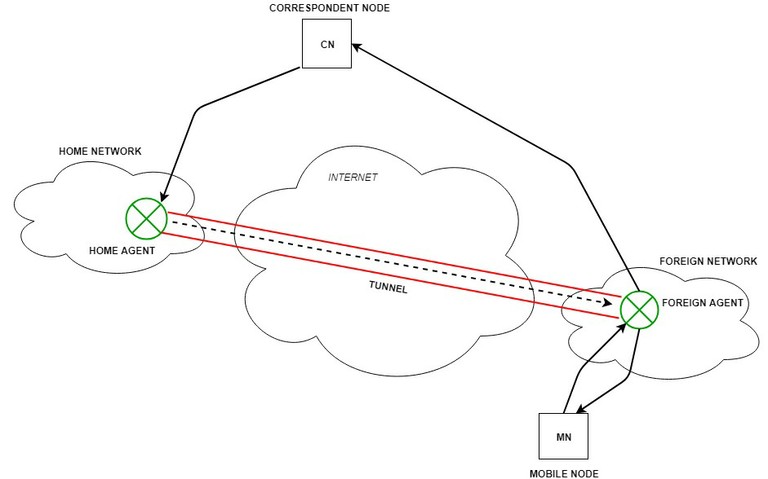Mobile IP Technologies
- Overview
An interesting aspect of the network that has been developed is the Mobile Internet Protocol (Mobile IP). This protocol is a protocol built on top of existing Internet protocols. In order to fully understand Mobile Internet Protocol, we must understand what Mobile IP is, how the protocol works, and why it is useful in our modern society. and some problems that may be discovered.
Mobile IP is an Internet Engineering Task Force (IETF) standard communications protocol that is designed to allow mobile device users to move from one network to another while maintaining a permanent IP address.
Mobile IP for IPv4 is described in IETF RFC 5944, and extensions are defined in IETF RFC 4721. Mobile IPv6, the IP mobility implementation for the next generation of the Internet Protocol, IPv6, is described in RFC 6275.
- Node Mobility
Nodes wishing to communicate with a mobile node use the mobile node's permanent home address as the destination address for outbound packets. Because the home address logically corresponds to the network associated with the home agent, traditional IP routing mechanisms forward these packets to the home agent.
Instead of forwarding these packets to destinations physically located on the same network as the home agent, the home agent redirects the packets to a foreign agent.
The home agent searches the mobile binding table for the care-of address and tunnels the packet to the mobile node's care-of address by appending a new IP header to the original IP packet (preserving the original IP header).
At the end of the tunnel, the packet is detected by removing the IP header added by the home agent and delivered to the mobile node.
The mobile node sends packets directly to another corresponding node through the foreign agent, without the involvement of the home agent, using its permanent home address as the source address of the IP packet. This is known as triangular routing.
A foreign agent can use reverse tunneling to route packets from a mobile node to its home agent, which then forwards the packets to the corresponding node.
This mechanism is necessary in networks where the gateway router has ingress filtering enabled. Therefore, the mobile host's source IP address must belong to a subnet of the foreign network; otherwise, the packet will be dropped by the router.
The Mobile IP protocol defines an authenticated registration process through which a mobile node can register its care-of address, router discovery (which allows the mobile node to discover potential home and foreign agents), and packet routing rules to and from the mobile node. It includes specifications for a mandatory tunneling mechanism and multiple optional tunneling mechanisms.
- Mobile IP Technologies
- A mobile node (MN) is a handheld communication device carried by a user, such as a mobile phone.
- The home network is the network to which the mobile node initially belongs based on its assigned IP address (home address).
- Home agent (HA) is the router in the home network to which the mobile node initially connects
- A home address is a permanent IP address assigned to a mobile node (within its home network).
- A foreign network is the current network that a mobile node is visiting (away from its home network).
- A foreign agent (FA) is a router in the foreign network to which the mobile node is currently connected. Packets from the home agent are sent to the foreign agent, which delivers them to the mobile node.
- A communication node (CN) is a device on the Internet that communicates with mobile nodes.
- A care-of address (COA) is a temporary address used by a mobile node when it leaves its home network.
- External agent COA, COA can be located at FA, that is, COA is the IP address of FA. FA is the tunnel endpoint and forwards packets to the MN. Many MNs using FA can share this COA as a public COA.
- Co-located COA,A COA is co-located if the MN temporarily acquires an,additional IP address as the COA. The address is now topologically correct and the tunnel endpoint is at the MN. You can obtain a co-located address using a service such as DHCP.
- Applications
In many applications (e.g., VPN, VoIP), sudden changes in network connectivity and IP address can cause problems. Mobile IP was designed to support seamless and continuous Internet connectivity.
Mobile IP is most often found in wired and wireless environments where users need to carry their mobile devices across multiple LAN subnets. Examples of use are in roaming between overlapping wireless systems, e.g., IP over DVB, WLAN, WiMAX and BWA.
Mobile IP is not required within cellular systems such as 3G, to provide transparency when Internet users migrate between cellular towers, since these systems provide their own data link layer handover and roaming mechanisms. However, it is often used in 3G systems to allow seamless IP mobility between different packet data serving node (PDSN) domains.
[More to come ...]


